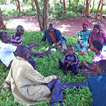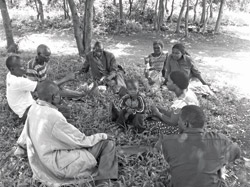It’s HUGE
Five Lessons the American Church is Learning from Church-Planting Movements

News of Church-Planting Movements (CPMs) happening around the world has been a wake up call for many American church leaders to reexamine, reframe and retool. Others have simply dismissed rapid multiplication of churches as impossible to happen in the U.S.
Tim Martin, Mission Pastor at WoodsEdge Community Church in Houston expresses what many church leaders describe when they hear of and are amazed by all that God is doing through these movements around the world. “I think it’s starting to bounce back to America, causing us to radically rethink our whole paradigm of church and mission. I now believe there can be much more, and there must be more.”
The speed of movements, the depth of discipleship and commitments of the emerging leaders, frequently cause pastors in the West to pause. This is because CPMs tend to create a questioning dissonance with our contemporary models, experience and traditions about what it means to be “church.” “It has forced me back to the Scripture for my understanding of ‘church,’” said John Lo, pastor at Epicentre Church in Pasadena, CA. “The re-framed concepts learned from CPMs have been ‘huge’ for me,” he emphasized.
Those who have chosen this journey express that, for the church in America, it has been an explosion of HOPE for a different future. Five lessons were most often mentioned as the important shifts taking place for them.
1. COME & GO: The shift from inviting unbelievers to come to our programs and building to sending believers into their world.
Jesus said that the fields are ready for harvest. To live in this reality, the way of thinking has to intentionally change from “Come” to “Go.” God always asks Christians to go to those without him; never the lost to come to church or into Christian space. When this shift in thinking happens, church members start to identify and pray specifically for those in their world who don’t yet know Him. This is because the idea of “going” becomes embedded into church life. Similarly, church leaders are much more intentional about training believers to tell their own story and God’s story in simple, short and compelling ways. Frequently, they will use the Creation to Christ story, a 10-15 minute overview of the Bible starting in creation and culminating in Christ.1 In many cases programming schedules have been radically altered to release their people to “go” more often, and with greater intentionality.
John Lo thinks of “Come” structures as the Old Testament temple where people gathered and the professionals served. “But Jesus said, my body is the temple; and then the temple started walking around. Jesus gave his body instructions to ‘Go’ in Matt. 9. 37-38; Matt. 28.19-20 and Acts 1.8.”
Linda Bergquist, church planter catalyst and mentor in the San Francisco area observed, “Jesus did not assign the 70 as a core group for a new come structure, but instead sent them decentralized by twos.”
2. GROUP CONVERSIONS: The shift to multiplying groups of disciples not just individual disciples.
Kevin Johnson, mission pastor at Antioch Community Church in Waco, Texas says, “We had to get back to oikos: households; life on life.” In CPMs around the world, the Kingdom is established in a relationally-connected group and then spreads group to group. The Scripture refers to each of these groups as a household. The Greek word for household is oikos, and includes a circle of influence, not just immediate family.
The promise of Acts 11:14 and 16:31 is that networked groups will come to faith. The key is to not extract an individual from his or her oikos when there is spiritual hunger, but to disciple the group together into faith. This is in contrast to what has been the general U.S. pattern. Typically, we see individuals come to faith and then we disciple them individually, and sometimes not very well if at all. In many CPMs the early phases of discipleship often happen before faith, as the unbelieving group meets and explores what it actually means to follow Christ. Or, the early discipleship happens post-conversion but as a group of connected individuals walking down the same path together. These individuals do not have to be family. In many CPMs these groups are the relationships that fit the context—workmates, classmates, members of the same extra-curricular avocation.
3. COUNTING GENERATIONS: The shift to count and do whatever it takes to regularly and quickly get to the 4th generation and beyond of disciples, groups and churches (II Tim. 2.2).
The process of getting quickly to the next generation of disciples, leaders and groups is well established where Church-Planting Movements are taking place. One helpful tool has been the three-thirds format for group meetings, where caring, infusion of vision, mutual loving accountability, learning the Word, goal setting, practice and prayer are integrated into a seamless and regular process. Each week members of the group live in life-on-life accountability to love the Lord unconditionally and pursue His Commission in reaching and loving others. This process is described in T4T: A Discipleship Re-Revolution2. A key focus for the group is to win and train the next generation of disciples who will repeat the process.

Amazingly, this process is not just fruitful overseas. Where the principles and process of generational growth are applied in small group meetings and leadership development, it has similar outcomes in the U.S.3 The values-imprint on the new believer is another make-or-break element in getting to the next generation. Rather than take a new believer to a “come” meeting where they sit and listen, their new life in Christ must start in a very different way. The individual is encouraged to start a group in his/her oikos. This is where they are taught to study and obey God’s Word and they are equipped to immediately pray for and witness to those they know. When this approach is successful, group members are given the vision, tools and the time to practice, along with loving encouragement, to win the next generation.
This leads to a second critical factor which is the continual vision for reproduction of the next generation. Each member and each group strives to be a parent, grandparent and great grandparent. One effective CPM catalyst in the U.S. describes it this way: “I evaluate my disciple-making not by my disciples, but by my disciples’ disciples.” All along the way the groups celebrate each new generation. What we envision, measure and celebrate determines the outcome.
4. REPRODUCIBILITY: The shift from lengthy training, policy-driven structures and more academic materials to simplicity and the reproducibility of means, methods, tools and structures.
Equipping and training is best accomplished by modeling with simple tools. Easy-to-learn and obey lessons in the hands of new believers allow them to do what they have just seen done by a mentor. When they are equipped simply, they disciple those they lead to faith in the same manner, often with only a few moments of encouragement and clarification.
Kevin Johnson says, “We’ve had to learn to just keep it simple, simple, simple in the Antioch community. Our lessons are now simple; our evangelism tools are simple. We’ve had to create an environment where there can be many different expressions of small group and where people are released quickly to be more evangelistic and apostolic.”
Simple does not mean simplistic – reducing truth beyond its core essence. Rather it means taking deep truths and applications and learning and expressing them in a way that an average new believer can obey and pass on to others. A trait of every CPM in the world is the use of one simple method for evangelism, discipleship and church planting. While many methods could suffice, using a multiplicity of methods confuses new believers. Instead, using just one appropriate and reproducible method enables an explosion of growth as new believers, led by the Spirit, are able to serve as ministers to others. A simple method enables a shorter on-ramp to enable new believers to mature and disciple others. This is a lesson these U.S. churches are applying to their context.
5. OBEDIENCE-BASED LEARNING: The shift from teaching for knowledge of what the Word says to teaching accountability for obedience to what the Word says.
This states the obvious. “Of course we are to teach for obedience.” Many wonder how we missed this for so long? The Great Commission is not “teaching them all that I have commanded,” but “teaching them to obey all that I have commanded” (Matt. 28:20). It’s only in putting off the old and putting on Christ, as believers apply His Word, that we find quickly transformed and strengthened lives.
George Patterson points out that, when we keep teaching after believers quit obeying, we are actually teaching them that it’s okay to “study and not obey” or “pick and choose what we want to obey.” In this distortion of discipleship, we are heaping judgment on those we teach, as they must give an account one day for what they know and have not obeyed.
Transformed lives are the fuel to ignite movements. Transformed lives prove that Jesus can change things, and everyone needs a God who can act in power on their behalf. Transformed lives become change agents themselves.
CPMs are teaching us that discipleship can be a rapid maturing process, but this only comes by keeping discipleship obedience-based. Believers must be expected to obey, encouraged to obey and held accountable to obey in the spirit of Hebrews 10:24-25.
As these shifts in understanding are taking place, changes have begun. Christians are getting out of the building and out of their comfort zones. There is deep rejoicing that we are seeing more and speedier conversions, new groups, and intentional church planting.
As church leaders embrace these ideas, they start conversations to learn from one another to work out the cultural nuances involved in their particular context. Several common themes consistently emerge in such discussion. The first is that even when new groups begin with positive momentum, they often find that cultural gravity pulls them back into the old way of thinking. People revert to inviting the lost or new believers to “come” to existing Christian meetings. Jeff Sundell, a CPM catalyst in North Carolina says, “This is a killer for generational growth.”4 In our U.S. culture, it takes a while to re-condition even new believers to move away from the “come” mentality to the “go” mentality.
Another issue is that we often don’t stay with the emerging leadership long enough to regularly see them through to the point of generational multiplication. In our U.S. eagerness to finish the next program, we “finish” our set of discipleship lessons with a first generation group and then abandon them once the lessons are over. We must learn from CPMs overseas to stay with groups for a year or two to help them birth new groups that birth new groups. We must keep our eyes on the end-vision, not simply the short-term discipleship.
The lessons from CPMs for the U.S. church are huge, inspiring re-examination which takes us back to the Scripture for both principles and practice. But the reframing and retooling continues to be a little bit messy. Let us persist until this way of life becomes the new normal.









comments